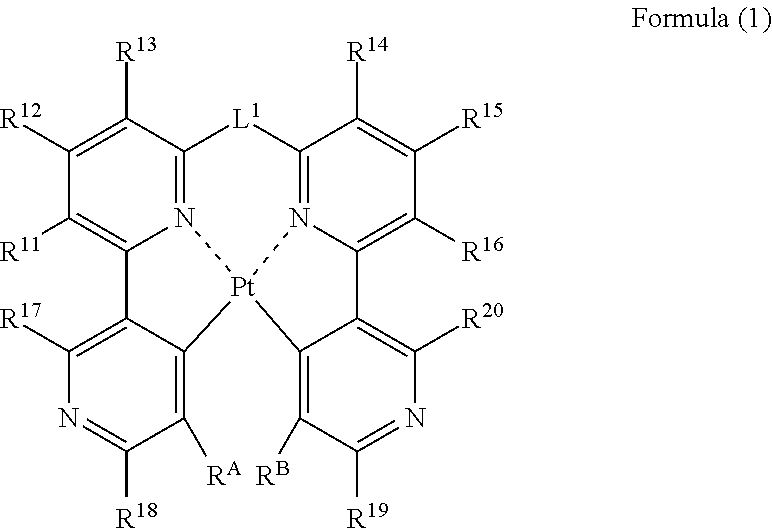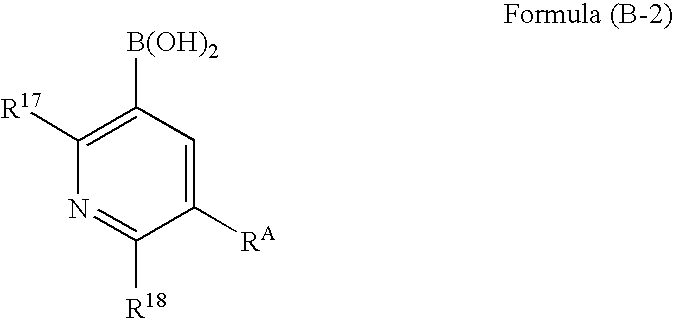Organic electroluminescence device
a technology of electroluminescence device and organic material, which is applied in the direction of discharge tube luminescnet screen, other domestic articles, natural mineral layered products, etc., can solve the problems of difficult control of the generation of complexation byproducts, and the inability to achieve devices satisfying both high efficiency and durability, and achieves excellent durability and high luminance devices. , the effect of improving the yield in the complexation step
- Summary
- Abstract
- Description
- Claims
- Application Information
AI Technical Summary
Benefits of technology
Problems solved by technology
Method used
Image
Examples
example 1
[0230]
Synthesis of Compound J2
[0231]A mixture composed of Compound A1 (3.56 g, 10.0 mmol), 2-fluoropyridyl-3-boric acid (4.23 g, 30.0 mmol), palladium acetate (0.11 g, 0.5 mmol), triphenylphosphine (0.52 g, 2.0 mmol), sodium carbonate (10.6 g, 0.1 mol), 1.2-dimethoxyethane (100 mL) and water (100 mL) is stirred for 5 hours at 80° C. in a nitrogen atmosphere. After cooling to room temperature, the reaction mixture is filtered, followed by extraction with chloroform. The organic layers are combined, dried, and concentrated. The residue thus obtained is purified by column chromatography. Recrystallization from ethanol is then performed to yield 1.90 g of Compound J2 in the form of white crystals. The yield is 490%.
[0232]1H-NMR (300 MHz, CDCl3) δ: 1.93(s, 6H), 7.21(d, J=9.0Hz, 2H), 7.30(m, 2H), 7.69(t, J=9Hz, 2H), 7.78(d, J=6.0Hz, 2H), 8.23(m, 2H), 8.64(m, 2H).
[0233]
Synthesis of Exemplified Compound 1
[0234]In benzonitrile (50 mL), platinum chloride (2.2 g, 5.0 mmol) and Compound J2 (2.2...
example 2
Synthesis of Compound S2
[0236]
[0237]A mixture composed of Compound A1 (0.83 g, 2.3 mmol), 6-fluoropyridyl-3-boric acid (1.0 g, 7.0 mmol), palladium acetate (26 mg, 0.12 mmol), triphenylphosphine (121 mg, 0.46 mmol), sodium carbonate (2.4 g, 23 mmol), 1,2-dimethoxyethane (25.0 mL) and water (25.0 mL) is stirred for 1.5 hours at 85° C. in a nitrogen atmosphere. After cooling to room temperature, the reaction mixture is filtered with cerite, followed by extraction with ethyl acetate. The organic layers are gathered up, dried, and then concentrated. The residue thus obtained is purified by column chromatography, thereby yielding 0.7 g of Compound S2 in the form of a white solid. The yield is 85%.
Synthesis of Exemplified Compound 2
[0238]
[0239]In a nitrogen atmosphere, platinum chloride (137 mg, 0.52 mmol) and Compound S2 (200 mg, 0.52 mmol) are stirred into benzonitrile (5 mL) for 6.5 hours under heating and refluxing conditions. The reaction mixture is cooled to room temperature, and a ...
example 3
Synthesis of Exemplified Compound 3
[0240]
Synthesis of Compound A2
[0241]In a nitrogen atmosphere, a three-necked flask is charged with Compound A1 (2.0 g, 5.62 mmol), 2,6-difluoropyridyl-3-boric acid (2.14 g, 11.24 mmol), palladium acetate (63 mg, 0.281 mmol), triphenylphosphine (294 mg, 1.12 mmol), sodium carbonate (5.96 g, 56.2 mmol), 1,2-dimethoxyethane (40 ml) and water (40 ml). The resulting mixture is heated under reflux for 6 hours and 30 minutes while stirring. After cooling to room temperature, the reaction mixture is extracted with ethyl acetate. The organic layer thus obtained is dried over sodium sulfate and filtered, followed by concentration. The residue obtained is purified by silica gel column chromatography (chloroform) to yield 1.81 g (yield: 76%) of Compound A2 in the form of white crystals.
[0242]1H-NMR (CD2Cl2, 300 MHz,) δ: 1.95 (s, 6H), 7.00 (ddd, J=0.9, 3.0, 8.1 Hz, 2H), 7.30 (dd, J=2.4, 6.6 Hz, 2H), 7.74-7.80 (m, 4H), 8.72 (dt, J=8.1, 9.6 Hz, 2H)
Synthesis of Ex...
PUM
| Property | Measurement | Unit |
|---|---|---|
| temperature | aaaaa | aaaaa |
| temperature | aaaaa | aaaaa |
| temperature | aaaaa | aaaaa |
Abstract
Description
Claims
Application Information
 Login to View More
Login to View More - R&D
- Intellectual Property
- Life Sciences
- Materials
- Tech Scout
- Unparalleled Data Quality
- Higher Quality Content
- 60% Fewer Hallucinations
Browse by: Latest US Patents, China's latest patents, Technical Efficacy Thesaurus, Application Domain, Technology Topic, Popular Technical Reports.
© 2025 PatSnap. All rights reserved.Legal|Privacy policy|Modern Slavery Act Transparency Statement|Sitemap|About US| Contact US: help@patsnap.com



